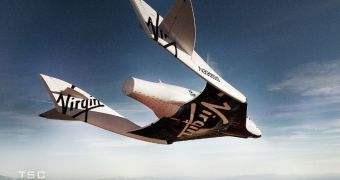Officials with Virgin Galactic, the company developing the SpaceShipTwo suborbital aircraft, say that the vehicle's first powered flight could occur by the end of this year. If the test is successful, then commercial rides to the edge of space could begin as early as 2013 or 2014.
The suborbital aircraft can reach altitudes of about 110 kilometers (68 miles), enough to allow six passengers and two crewmembers to experience several minutes of weightlessness. The price of such a joyride is currently $200,000 per seat.
SpaceShipTwo is not large enough to be launched to space directly, so Virgin Galactic decided to develop a carrier aircraft, called WhiteKnightTwo. The space-bound vehicle is attached under the belly of the larger aircraft, and then taken to around 50,000 feet (15 kilometers) for deployment.
After separation, the SpaceShipTwo fires up its RocketMotorTwo liquid/solid hybrid rocket engine, which boosts it to suborbital altitudes. During a standard flight, it will not be able to complete an entire orbit around the planet, Space reports.
As the flight draws to a close, the vehicle will fold its wings, and then drop through the atmosphere, back to a safe landing site, most likely Spaceport America, in New Mexico. Tests are currently being conducted from the Mojave Air and Space Port, in California.
Thus far, the SpaceShipTwo carried out about 16 unpowered flight tests, and officials at Virgin Galactic are convinced that it can handle a powered flight. “That is something I can't give you an exact date on, but it should be sometime later this year,” said William Pomerantz.
“We are already in the process of preparing that,” said the Virgin vice president of special projects, during the 2012 Next-Generation Suborbital Researchers Conference (NSRC-2012).
Pressure is building on the company to get things going. Thus far, it has managed to sign about 500 customers for upcoming trips, and these people want to go to space as soon as possible. Their investment and trust is partially what allowed Virgin Galactic to construct its business so quickly.
“We're about to break 500. That's a nice milestone for us, especially when you consider that, if you add up every astronaut NASA's ever flown, plus every cosmonaut that the Russians have ever flown, every taikonaut the Chinese have ever flown, that's about 525,” Pomerantz concluded.

 14 DAY TRIAL //
14 DAY TRIAL //